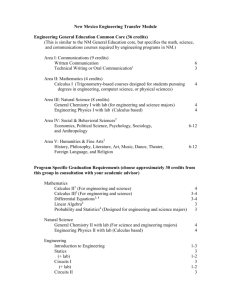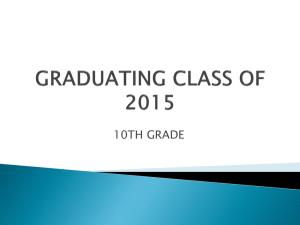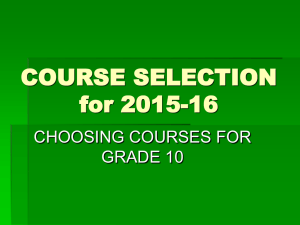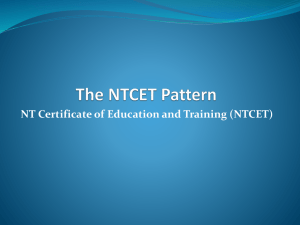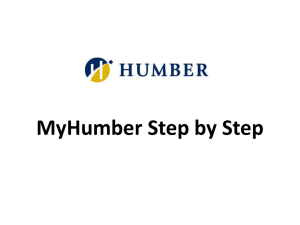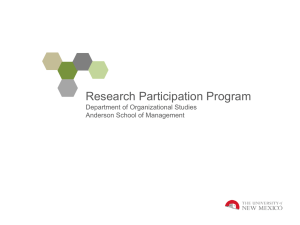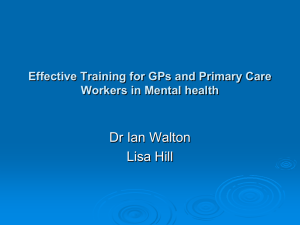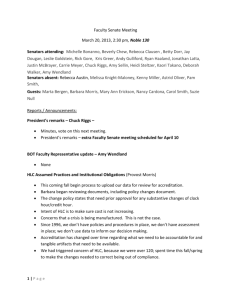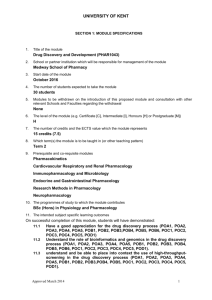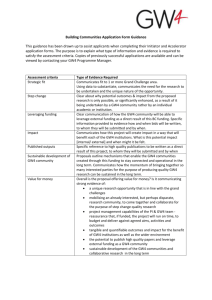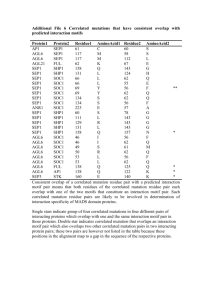Outcome-Based Education in Hong Kong Higher Education
advertisement
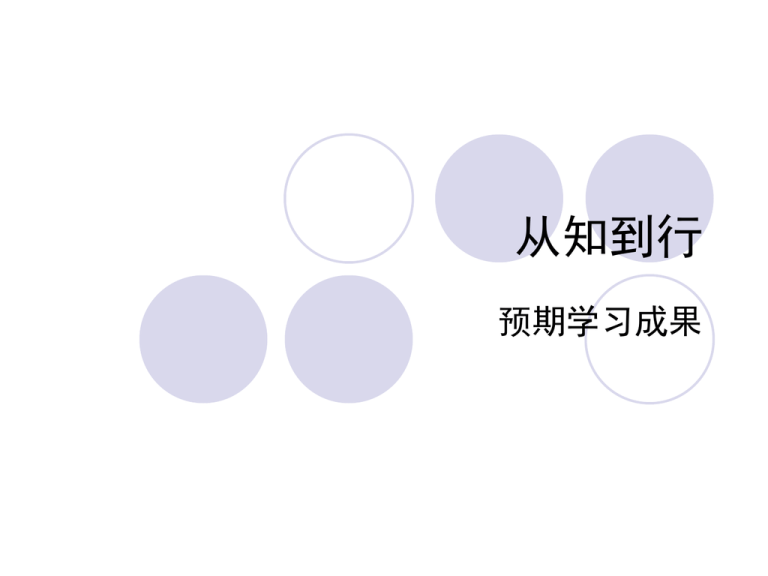
从知到行 预期学习成果 讨论 学好数理化 ,走遍天下都不怕 香港高等教育的处境 教学质量问题 知识爆炸性地增长,但大学教得越多,学生学到的越少 学生在中学阶段习惯了应试教育,考完马上忘记,没有积 累 学生在中学阶段的课外经历少,导致高分低能,知识转移 能力差 毕业生欠缺解难、创新、沟通、合作等共通能力 (Generic Skills) 社会和经济压力 社会对毕业生的就业率有期望 毕业生需要和内地学生竞争 香港高等教育的改革 政府通过额外拨款引导 引入成果为本教育(Outcome-based Education)理念 以大学为主体,自上而下推行 长期、多阶段的实施 成果为本教育的主要功用 质量提升(Quality Enhancement) 质量保障(Quality Assurance) 不同地区采用成果为本课程设置的目的 美国 – 院校资格评审(Institution Accreditation) 澳洲 – 界定毕业生的必要属性(Graduate Attributes) 欧盟波隆纳进程 – 学历框架(Qualification Framework) ABET等专业团体 – 专业评审(Programme Accreditation) 香港理工大学 – 促进学习(Improvement of learning) 成果为本教育(OBE)的要点 以预期学习成果(Expected Learning Outcomes) 界定教学内容 学习成果是完成学习后学生应该具备的工作能力 以客观的标准(Criterion)来评定学生的能力 评估手段与能力的应用匹配 评估学生的总体表现 形成性、有助学生改进学习成效的评估 Adapted from Biggs, 2003 香港理工大学课程改革的支柱 要到哪里去 OutcomeToriented Curriculum 成果为本课程设置 CriterionTreferencing Assessment Package 标准参照评估 Active Learning Pedagogy 主动学习 是否到了那里 怎样到那里去 标准参照评估课程配套(CriterionReferenced Assessment Package) 每个专业的标准参照评估课程配套由三份文件组 成 1. 专业设置文件(Definitive Programme Document)是香 港理工大学各专业的规范,当中列明 专业目的(Programme Aims) 专业学习成果(Programme Learning Outcome) 课程设置(Course Structure) 课程学习成果对照表(Curriculum Map) 课程大纲(Subject Syllabus) 2. 评价策略(Assessment Scheme) 3. 评分量表(Performance Standard) 讨论 【目标】 【目的】 ①射击、攻击或寻求的对象: 看清~|发现~。②想要达到的境 地或标准:奋斗~。 想要达到的地点或境地;想要 得到的结果|~地|~是想探索问 题的由来。 要到哪里去 OutcomeToriented Curriculum 成果为本课程设置 教学活动的目的是要学生取得预期中的学习成果 教学的目标是从教学目衍生,为教学计划而制订的标准 当教学目标与现实情况出现矛盾,应根据教学目的重新制订目标 讨论:课程目的 懂得如何使用AutoCAD建立3维 模型 熟悉课程设计的方法、建设思 路 以学科内容为目标 为学而学 能够使用AutoCAD或同类软件, 将设计构想转化为数字模型 能够设计和建设有成效的课程 以学习成果为目的 针对知识的应用 专业目的和课程目的 预期学习成果是多层次的 专业目的描述学生毕业时 应具备的能力和素养 制订专业目的的参考 专业知识结构 区域政经发展趋势 学会意见 企业、行业协会意见 大学使命和愿景 课程目的根据专业目的而 编写,描述学生完成课程 时应具备的能力和素养 专业 POC1 SOC1 POC2 SOC2 课程 POC3 SOC3 POC4 SOC1 SOC2 课程 知识、技能、价值 学习成果的三种类型 【掌握】 ①了解事物,因而能充分支配或 运用:~技术|~理论|~原则|~规律 ◇~自己的命运。②主持;控制: ~会议|~政权。 现代汉语词典,2002,商务印书馆 过量教学 内地高校多用掌握作为教学目标,滥用掌 握将导致 学生负担过重,学习能力、精力、时间浪费 学生难以获得学习满足感 教学难于准确定位,导致教学措施不到位 成绩泛化,难于区分背诵知识和盲目操作 成果为本教育要求,将课程要求达到的目 的分为知识、技能、价值三类 知道、能够、会 知识(Academic Knowledge) 学生应该知道(should know)的原理和规律 传统教育的主体 技能(Performance of Understanding) 学生应该能够(should be able to)支配所学知识来执行的具 体活动 表现(Performance)须要通过操作(Perform)来体现 体现教育对社会的贡献 价值观(Values) 价值观(Value)、取向(Orientation)和态度(Attitude) 有不同的涵义 学生应该坚持(should be like)的行为 学生在面对两个同样可行的选项时,明确挑选其一,并对自己 的选择感到自豪 知道、能够、会 理解和预测 事物 知识 技能 价值 操作 事物 事物 知识、技能、价值观之间的转化 知识 学生应该知道脂肪与蛋白质的分别 学生应该知道现今通行的各种脂肪与蛋白质分离技术 技能 学生应该能够烧一道脂肪与蛋白质成分均衡,有益健康的 菜 学生应该能够设计在大量生产条件下把牛奶中的脂肪与蛋 白质分离的设备 价值观 学生会确保不向服务对象提供含过量脂肪的饮食 学生会持续不懈地提高蛋白质的提取率,节约地球资源 试将下列教学成果分为 知识、技能、价值3类 1. 2. 3. 4. 5. 6. 7. 8. 9. 10. 11. 应用数学、科学和工程知识的能力 an ability to apply knowledge of mathematics, science, and engineering 设计并进行实验,分析、诠释实验数据的能力 an ability to design and conduct experiments, as well as to analyze and interpret data 在现实的经济、社会、政治、道德、健康、安全、可生产性、可持续性制约下设计系统、元件或过程以满足需 求的能力 an ability to design a system, component, or process to meet desired needs within realistic constraints such as economic, environmental, social, political, ethical, health and safety, manufacturability, and sustainability 在跨界别团队中发挥作用的能力 an ability to function on multidisciplinary teams 发现、分析和解决工程难题的能力 an ability to identify, formulate, and solve engineering problems 明白各种专业和道德责任 an understanding of professional and ethical responsibility 有效地沟通的能力 an ability to communicate effectively 足以理解工程方案对全球的经济、环境和社会的影响的广博学识 the broad education necessary to understand the impact of engineering solutions in a global, economic, environmental, and societal context 认识终身学习的需要,有能力参与终身学习 a recognition of the need for, and an ability to engage in lifeTlong learning 对当前各种议题的认识 a knowledge of contemporary issues 在工程实践中运用各种技术、技巧、现代工程工具的能力 an ability to use the techniques, skills, and modern engineering tools necessary for engineering practice CRITERIA FOR ACCREDITING ENGINEERING PROGRAMS 2007/08, Accreditation Board for Engineering and Technology, ABET 1 知 识 技 能 价 值 2 3 4 5 6 7 8 9 10 11 讨论 知识 足以理解工程方案对全球的经济、环境和社会的影响的广博学识 对当前各种议题的认识 技能 在工程实践中运用各种技术、技巧、现代工程工具的能力 有效地沟通的能力 在现实的经济、社会、政治、道德、健康、安全、可生产性、可 持续性制约下设计系统、元件或过程以满足需求的能力 发现、分析和解决工程难题的能力 应用数学、科学和工程知识的能力 设计并进行实验,分析、诠释实验数据的能力 在跨界别团队中发挥作用的能力 价值 明白各种专业和道德责任 认识终身学习的需要,有能力参与终身学习 Accreditation criteria for Engineering / Applied Science programmes, Accreditation Board for Engineering and Technology, ABET 课程预期学习成果的制订 布卢姆认知目标新分类(Bloom’s Taxonomy of Educational Objectives) 目标动词(Action Verbs) Create(创造) Evaluate(评价) Reflect(反思) Apply: far problems(应用:遥远问题) Hypothesize(假设) Relate to principle(与原理关联) Apply: near problems(应用:就近问题) Explain(解析) Argue(争辩) Relate(关联) Comprehend: main ideas(理解:中心思想) Describe(描述) Enumerate(列举) Paraphrase(意译) Comprehend : sentence(理解:段落) Identify, name(指出、说出) Memorize(熟记) etc. 高阶, 复杂 初阶, 简单 掌握能力的程度和范围 Scope Scope 能 修改 从 开放原始码领域 寻获 Knowledge: Script syntex All roundness: Critical thinking and logic Knowledge: Common source of free scripts Scope Scope 的 客户端程序,用以 扩展 网页 的 功能 Skill: The ability to improve existing solution 一项可操作的学习目标: 必须有适当的范围(Scope) 必须真实(Authentic),来自现实生活 应与课程的程度和专业的要求匹配 以目标动词界定 可以同时包含知识、技能和价值,但应以其中之一为关键 课程学习成果实例 OC1 Plan and execute physical modelling process to explore and improve the aesthetic quality of the product being designed OC2 Build neat and sturdy Attributes forsketch models suitable for communication and presentation allTroundness OC3 Document form exploration process and results using technical and visual vocabularies, allowing others to reconstruct or modify the form by CAD without loosing the design intent SO1: OC4 Nurture sensitivity to visual elements and To enhance the develop reflective visual skills that are relevant to allTround development future learning of students, particularly in the areas of global outlook, critical and OC5 Articulate plastic representation of ideas and creative thinking, social generate critical discourses in related topics and national responsibility, cultural appreciation, lifeTlong OC6 Develop an attitude to constantly evaluate learning, biliteracy and existing practices in the field trilingualism, entrepreneurship and leadership. 4年制本科专业设置 Minimum credit requirement for graduation General University Requirements (GUR) Discipline-Specific Requirement (DSR) Maximum total credits allowed without incurring a higher tuition rate 120 credits 30 credits 66 - 102 credits 150 credits Areas Language & Communication Requirements (LCR) English Chinese Cluster-Area Requirements (CAR) 3 credits from each of the following 4 cluster areas o Human Nature, Relations and Development o Community, Organisation and Globalisation o History, Cultures and World Views o Science, Technology and Environment and of which A minimum of 6 credits on subjects designated as "China-related" Other Requirements Leadership and Intra-personal Development Service-Learning Freshman Seminar Healthy Lifestyle (non-credit bearing) Total GUR credits Credits 9 (6) (3) 12 (3) (3) (3) (3) 3 3 3 Nil 30 专业设置对照表(Curriculum Map) 技能 POC1 POC2 POC3 POC4 POC5 POC6 POC7 POC8 基础课 专业课 S1 S2 S3 T T TP T P 知识 T P T P S4 项目 S5 S6 P P P P P P P P S7 S8 S9 M M M M M M M T T TP M P T 价值 T T P T P T M M P T: Teach(教); P: Practice(练); M: Measure(评) M 课程设置的主要问题和争论 基础课、公共课、专业课、专业选修课的配置比 例 理大普遍采用的比例约3:1:4:2,公共课不含政治课、军 事训练 项目化教学的角色(学完才用、刚学就用、边学 边用、为用而学) 理大普遍推行刚学就用、边学边用 通识教育的宽度 理大提供文化、历史、体艺、政经等课程 语言教育的定位 理大本科普遍要求学生修读2学分的专业英语和2学分的普 通话 合适的课程学习成果 通常在阅读学习目标后: 学生应该同意该课程有用 教师应能衡量教学内容所包括的范围 教师应能决定最有效的教学方式 审题员应能评定考题是否可靠地衡量学生的学习 成果 评卷员应知道什么答卷才能评‘良’ 成果为本教育的优点与局限 长处 交流的清晰性 实践形式的灵活性 实施结果的可比性 评价结果的可转换性 短处 成果定义困难 定义难以取得认同 学生个体性的割裂 结果出现的自然性与意外 性(会有意想不到的结果) 32 参考书目 盛群力等 教学设计 2005 高等教育出版社 北京 Accreditation Board for Engineering and Technology The Washington Accord National Academy of Engineering of the National Academies
